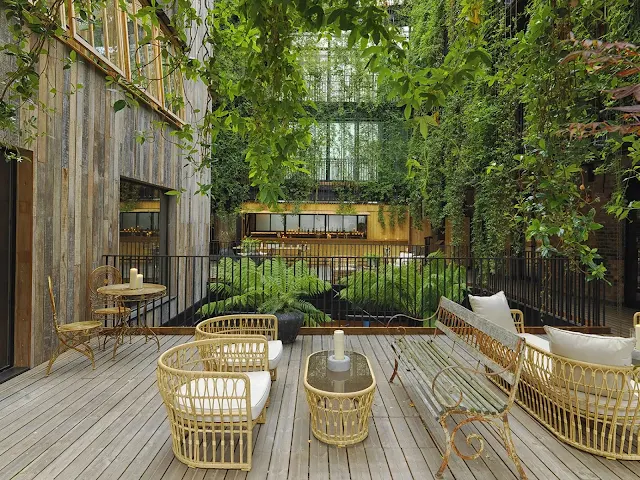Interior designer Tala Fustok and her art collector and hotelier brother Rami Fustok have created a sensuous city sanctuary at the Mandrake.
If you happen to be walking up Newman Street in London’ Fitzrovia, you’ll pass an understated charcoal shopfront with no hint of what lies beyond. The door leads into a dark tunnel; musky scents like fig and frankincense envelop you, and an Alice-in-Wonderland transformation delivers you into the exquisite demimonde that is the Mandrake hotel – a parallel universe of courtyard gardens, cascading vegetation, dim corners and hidden realms. The reception desk is a small booth in the wall: at the Mandrake, it’s the space itself that creates the welcome. “The aim,” the hotel’s interior designer Tala Fustok tells Effect, “was to create something different – a new world in the heart of London.”
The intensely immersive Mandrake will not be for everyone. And that’s a good thing – try to please everyone, and you may end up pleasing no one. Design should involve taking risks, and the Mandrake has taken a singular vision and executed it with exhilarating conviction. “We wanted the property to excite,” says Tala, “through its carefully considered maze of rooms, eclectic mix of antiques, riots of colours, intoxicating sensory infusions, unique splashes of wild energy and fantastical design elements.”
Of these design elements, there are dazzling hits aplenty. These include the future-retro 70s styling of the padded booth in the Waeska Bar – it’s fabulous. The Jurema Terrace is an exotic fusion of tropicalia and biophilia, with Crespi-inspired bamboo furniture, plants tumbling from the sky, and the forest canopy of the courtyard garden below. Tala describes the “ancient Tasmanian Fern trees and a hanging garden of draping jasmine and passionflower,” and she explains how the botanical concept aligns with the hotel’s name: “The Mandrake is a Mediterranean plant of the nightshade family, with a forked fleshy root resembling the human form and which was once used in herbal medicine and magic.”
The aim was to create something different – a new world in the heart of London.
In the basement, graffitied walls channel an urban nightlife vibe. The washroom is like a Charlie & the Chocolate Factory laboratory. It’s madness – yet it works. “We didn’t just think outside the box – we disregarded the box,” says Tala.
Then there are the bedrooms. “There’s a story to tell about each of the rooms,” says Sinai Pedreschi, the Mandrake’s director of sales and marketing, who explains how a seam of spirituality is threaded throughout the hotel. “Every room has a different mask,” she says, referring to the art objects which are part-sculptural, part effigy. “And the sun rises in the light rooms and sets in the dark rooms.”
The dark suites are brilliantly atmospheric, with lights that subliminally ebb and flow, creating trippy, spectral zones. “We carefully built every room with vintage and one-off pieces from flea markets and antique shops,” says Tala, “And being hugely inspired by the Mandrake’s location, we made the most of local artisans who added a mix of glamour, wildness and eclecticism to the space.”
Tala Fustok, interior designer
On the ground floor, clever juxtapositioning of the restaurant, bar, lobby and gardens creates beguiling layers of vision that offer tantalising glimpses of spaces beyond – a spectacle that’s equally effective in the morning, where deep greens glint through layers of glass from the courtyard light; and in the evening, where restaurant lights glimmer through the courtyard into the bar.
Tala describes her favourite suite – the Mandrake Suite – as “a harmony of two cities colliding, with indulgent Parisian jewel-toned velvets, gilded mirrors and a commanding marble bathroom balanced with the cool London city vibe of earthy-toned draped curtains, curvaceous wing chairs and classical Victorian proportions.” She adds: “The bed is swathed in Bedouin-style folds of fabric and a standalone tub is set on a huge slab of black-veined Indian marble, handpicked in Italy.”
It’s worth mentioning here is that these immersive design details extend to the exceptional botanical-infused cocktails – and to the food. The South American-influenced YOPO restaurant is seriously good – yellowtail with aji tiradito balanced melt-in-the-mouth sashimi with a dressing of extraordinary lightness and unctuousness. Oysters – like the fish – were among the freshest we’ve experienced; grilled octopus had a just-caught texture and an addictive chargrilled smokiness. Seasoning across the board was perfectly calibrated. Rami Fustok and his executive chef George Scott-Toft have created in YOPO a triumph that underscores the obsessive passion with which they have approached the whole Mandrake enterprise.
Throughout, the Mandrake delivers on its mission. Its irreverent spirit pushes at – and often smashes through – any conventions you might hold of what a 5-star city hotel should be. It’s not a place to bring the kids – it’s a playground for grown-ups. The Mandrake cannot be accused of playing it safe. And that is to be celebrated.
Rella Group developed
The Mandrake Hotel London was developed by the Rella Group, a property development company based in the UK.
The Rella Group specializes in luxury residential and hospitality projects, with a focus on creating unique and distinctive spaces. They aim to deliver exceptional experiences through their developments, seamlessly blending contemporary design, innovation, and functionality.
The Mandrake Hotel London, located in the city's West End neighborhood, showcases the Rella Group's commitment to creating immersive and captivating spaces. The hotel is known for its luxurious interiors, vibrant art collection, and lush botanical gardens, offering guests a truly enchanting experience.
















No comments:
Post a Comment